The Electric Heat-In-Transit Tanker (bitumen trailer) revolutionised the design of bituminous tankers. The new tanker improves efficiency in transit, reduces risk for exposure to hot bituminous product and potentially explosive stored product, improves access for operation, reduces onroad travel time and subsequent fatigue, and challenged regulators to redefine safe transit requirements.
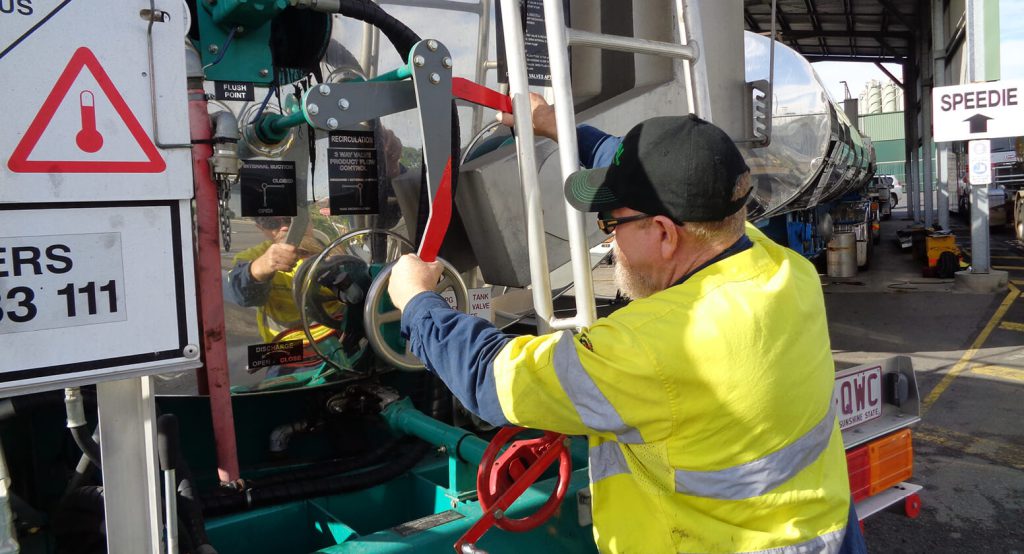
Design Product
Design tools were used from those developed in the mining industry and recommendations were made to help improve the human-centred design philosophy that can be applied to the design of capital equipment.
The Problem
Bituminous products are classified as hazardous goods at elevated temperatures (AS1940:2004).[i] Depending upon the grade of bituminous product, the product may reach temperatures up to 200°C, with a heating rate of up to 40°C per hour. Bitumen, in hot or molten state, presents hazards to workers for thermal burns, fume and toxic vapour exposure, respiratory tract or eye irritation, and exposure to irritating emulsifiers.[ii] Contained bitumen, under certain conditions, may be explosive.iii The transit of bituminous products for roadworks projects can be a dangerous task with extensive drive times and challenging heating requirements using a gas furnace on-site.
The design of bitumen trailers had not been addressed in a fundamental manner in over 30 years. This equipment is used routinely for asphalt roadworks projects and is retained in a business for 12–20 years – the inherent risks and design constraints are carried in a business for a long time.
Design Challenge
The challenge was to reduce drive and shift time of tanker operators (and, thus, fatigue), improve product heating and heat-retention methods, ensure safe transit and operations related to dangerous goods (hot bituminous product), improve equipment interface and access by operators and maintainers, isolate workers from operations requiring proximity to the tanker, improve efficiency and productivity, and improve operational performance reporting.
Essentially, the goal was to find a solution to change on-site liquid petroleum gas heating methods of bituminous products to a heat-in-transit system that made sense and maintained compliance for road transit of dangerous goods in a heavily regulated industry.
Design Methods
A certified professional ergonomist worked with the managing directors of the transport company to engage a six-step Design for Operability, Maintainability, Analysis Technique (d-OMAT). This involves critical task identification; hierarchical task analysis of the physical, cognitive, and organisational work demands including environmental conditions; hazard identification and analysis of risk; development of options for solutions (design strategy, concepts, and features); feedback and action planning with iterative design; and communication including via risk registers.[iv] Semi-structured interviews and task observations were undertaken with relevant measurements in natural and simulated conditions. The Earth Moving Equipment Safety Round Table (EMERST) Design Evaluation for Earth Moving Equipment Procurement (EDEEP) tool was applied, affording design philosophy and event severity analysis.[v]
This work was undertaken in consultation with the managing directors of the business, a maintenance worker, and operators. The managers consulted with the National Heavy Vehicle Regulator, the Australian Trucking Association, the principal engineering design firm, and other designers with relevant contributions globally, in preparation for design changes. Five site visits were made over 13 months to determine the scope of investigation for the project, conduct two job analyses, and confer with staff and management to determine risks and apply the EDEEP tool.
Further study was undertaken by the ergonomist about the organisational support systems to advance work design and this was modelling through a resilience-engineering technique using the Functional Resonance Analysis Method (FRAM Model Visualiser 0.4.1).[vi]
Initial Findings
Eighteen task-based hazards for operators were identified. The most serious were exposure to hot bituminous product and potentially explosive stored bitumen product. Fatigue risks were of great concern to the staff because of the extended hours of work with sustained driving in heavy industrial environments.
Twelve task-based hazards were identified for the bitumen tanker mechanic with the greatest concerns being exposure to hot product and equipment components when conducting “hot works”; slip, trip, or fall hazards; and hazardous manual task exposure.
Specifically, the following tasks were identified with the need for improved work design: administering bitumen discharge, working with contained product (explosive risks), heating product in tanker (requiring extended work hours which may be fatigue-inducing), extended driving periods, climbing atop the tanker to access hatches, hot works maintenance, and general maintenance.
Two hazardous conditions were not easily attributed to the EMERST design philosophy to identify potential unwanted events using the EDEEP tool: exposure to flash arcs from welding during maintenance and the risk for fatigue resulting from task exposure and product design (as opposed to the impact of fatigue affecting situation awareness and operational performance).
Design Solution
The new bitumen tanker provides an electrical heat-in-transit system (to heat and circulate bitumen) with a diesel package burner that can be used to lift heat when on-site.
The design includes interlocking roll-over activation and impact sensors in case of collision. The analog display of operating features was replaced with digital monitors within view outside the tanker and in the cab.
A remote control has been designed to enable operators to monitor the receiving tank while controlling the pump.
Valving can be operated from the ground and the delivery pipe was shortened to minimise the use of flush at an improved access height for the operator.
Automation has been added for access to a pneumatic, telescopic release side ladder with automated activation of top-of-tanker guard rails. This replaced the previous rear ladder and isolated workers from the valves and potential product exposure. One fewer hatches has been used atop the tanker and they have been recessed to improve heat retention, reduce weight, and reduce slip-trip-and fall risk among operators.
The barrels weigh 9.3 tonne, a saving of ½ tonne to other barrels, with a payload when coupled with a light speck prime mover just under 25 tonnes.
Regulatory authorities were required to change interpretations of safe transit of these dangerous goods to approve this heat-in-transit system which set a new precedent in the industry.
Design Impact
Form
The visual design enables comprehensibility and, thus, considers human factors in design: colour coding and directional signage on the bitumen discharge remote control enabled effective use and avoided erroneous activation of the pump functions; the digital visual display at ground-level access versus analogue at varied heights improved comprehension and manageability. The design of the trailer with recessed hatches and side-ladder is sleek so that form and function were well considered.
Function
The electrical heat-in-transit effectively heats and mixes bituminous product and has eliminated LPG as a heating fuel. The lightweight design is effective and increases cartage capacity. Fewer hatches are now recessed to aid heat retention and the design for thermal insulation has been effective. On-the-ground visual access to displays functions well. Remote control pump access enables workers to control and observe pump activity at a distance up to 100m, and the remote-control design (colour-coded and with directional symbols) aids comprehension. The side ladder with remote activation and telescopic set-up is preferred by workers.
Safety
The re-design isolated the worker from administering bitumen at discharge (burns and explosion) and reduced risk associated with working with contained product (explosive risk), heating product in the tanker (fatigue with longer work hours and extended driving). Fewer hatches, recessed hatches, and automatic guard rails reduced fall risks. Equipment interface at the rear of the tanker, which poses more exposure to valves (product exposures), was reduced with side-ladder installation and remote-control pump activation. Colour-coding and arrows on the remote-control panel help prevent erroneous activation. Regulatory approvals were obtained for the interpretation of standards pertaining to product heating in-transit.
Sustainability
Energy efficiency has been significantly enhanced through heat retention and thermal insulation design features. Heat-in-transit has reduced road-travel time and, thus, the environmental impact of on-road driving of heavy vehicles.
Ranging from 3 to 6 hours per shift, this could be significant across- industry if this design is adopted in a wide-spread manner. This aids business sustainability because of workforce productivity which can translate to competitive cartage quotes.
Quality
All relevant ISO engineering standards were met through the design of the new tanker.
The quality improvement exceeds the additional $12K invested in development.
Traditionally the barrel is constructed of mild steel and this re-design involved high-grade stainless steel which aided heat retention and tight outer wrapping of stainless-steel cladding (lagging).
Commerciality
The initial prototype cost $320K through the engineering process with an iterative design. The standard tanker would otherwise cost $308K so an extra $12K was expended plus in-kind engineering design was contributed. The payback of the extra $12K was realised within the first quarter of standard operation. The return on investment will continue to be realised throughout the 25+-year lifecycle. The capability of the transport company has been enhanced; more competitive bidding can occur with the efficiencies that have been realised. The engineering company will improve its profile as a market leader with the capability to provide a pioneering trailer design.
Innovation
This was a world-first endeavour to develop a heat-in-transit bitumen tanker, revolutionising tanker design, and the first known application of remote pump activation.
The design is new and original with ideation from Speedie Contractors; human-centred design facilitation, analysis, and reporting by ViVA health at work; and engineering design implemented by Holmwood Highgate.
FRAM Modelling
The FRAM model allowed for system analysis of the organisational functions that supported the design process that led to constructive and successful project outcomes. The FRAM model for the asphalt job truck design review is represented in Figure 1. The green functions (symbolised by hexagonal shapes) represent the 6-step process of Design-OMAT. Yellow functions represent additional resources and tools used in the equipment design review process. The blue functions represent organisational activities that supported the design process. Purple functions represent positive influences.
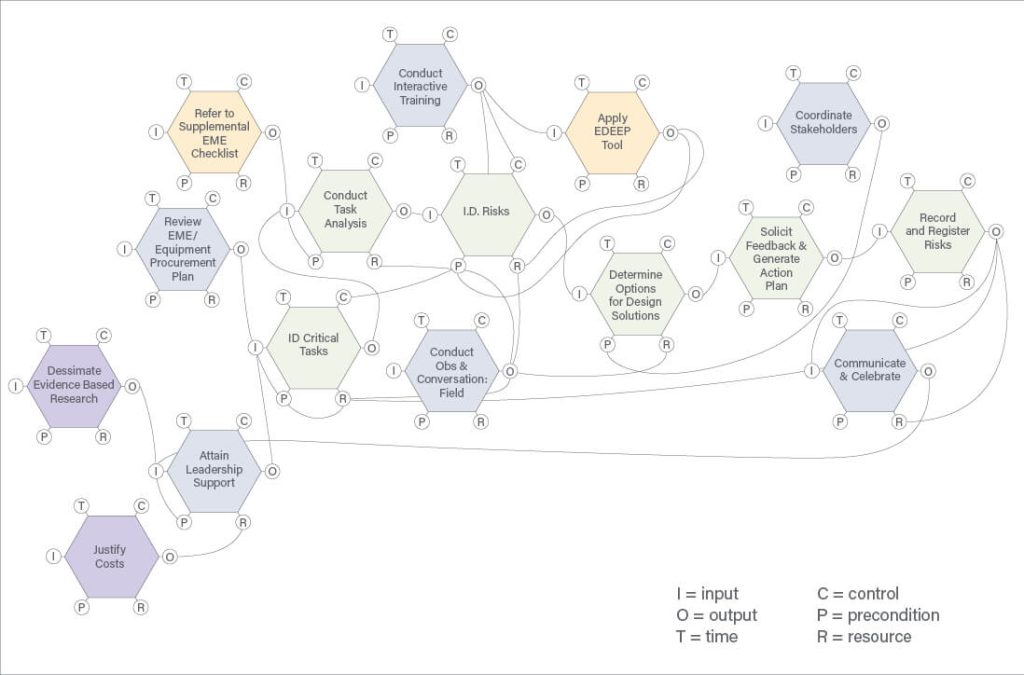
Bitumen Trailer Heat-in-Transit System
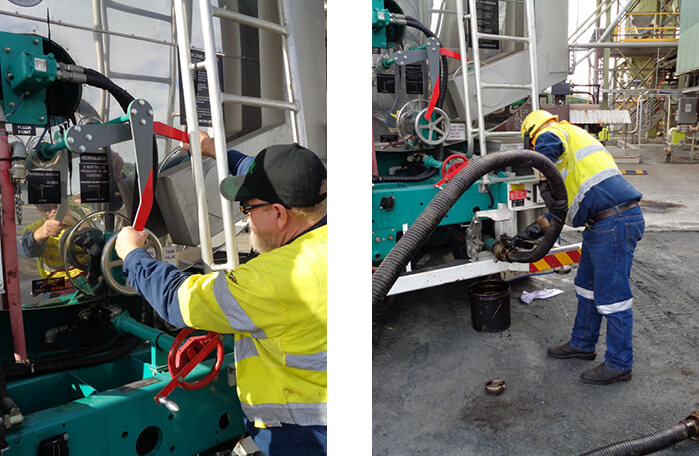
Figures 2 – 3: The levers and valves at the back of the trailer for bitumen discharge failed to isolate operators and maintainers from potential release of hot and explosive product.
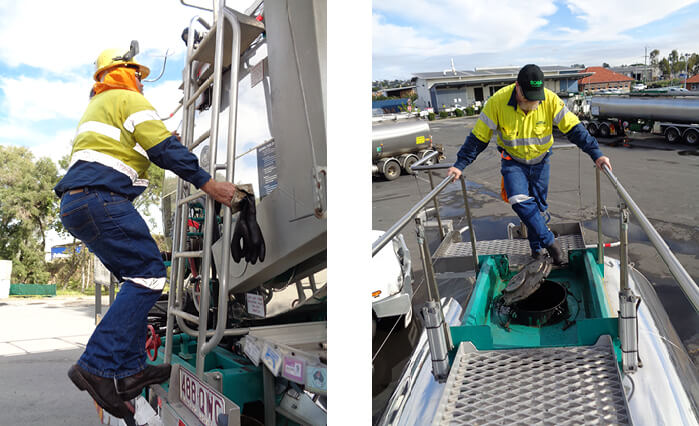
Figures 4 – 5: The ladders required climbing from the rear of the trailer, exposing operators and maintainers to potential points of release of bituminous product. They were weighty and requiring high initial and last steps to approach the top of the trailer. The guarding around hatches represented trip hazards and multiple hatches result in potential risk for heat dissipation. The side railing required manual operation.
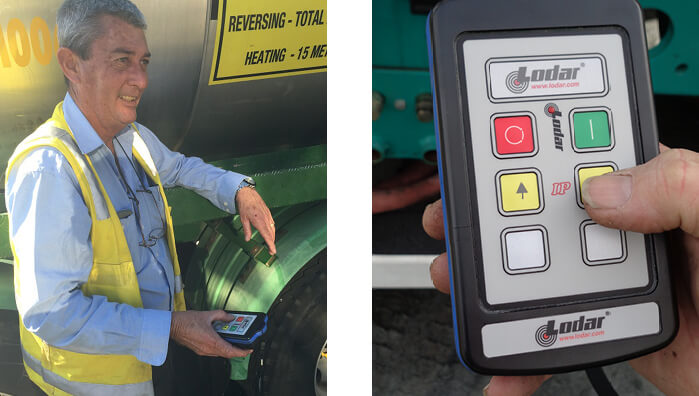
Figures 6 – 7: Remote control levers enabled the operators to discharge bitumen remotely, up to 100m, and isolate the worker from potential release points of hot and explosive product.
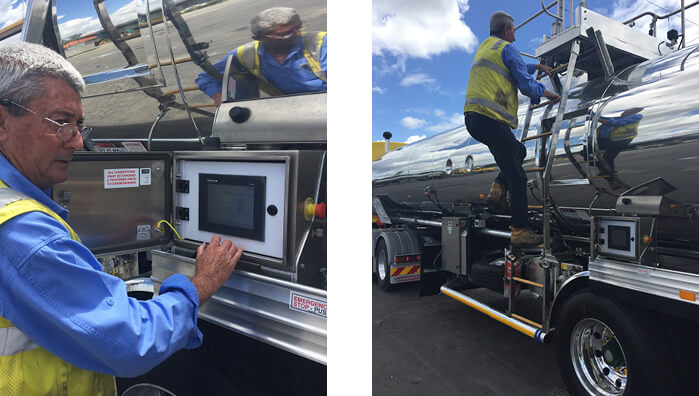
Figures 8 – 9: Analogue displays were changed to digital with information that could be conveyed centrally as well as on-equipment, and automated light-weight side ladders and railing helped reduce overall weight in transit, safe ingress/egress, and protection while working at heights. Top hatches were reduced in number (to one) and recessed to eliminate trip hazards and aid heat retention.
[i] Australian Standards: AS1940-2004. The storage and handling of flammable and combustible liquids.
Standards Australia: SAI Global.
[ii] Energy Institute (2005). Bitumen Safety Code: Model Code of Safe Practice in the Petroleum Industry, Part 11 (4th Ed.). London, UK: Energy Institute.
[iii] The Canadian Press (2009, 4 Sept). New Zealand worker killed in explosion of bitumen tank he was welding. The Canadian Press.
[iv] Horberry, T., J., Burgess-Limerick, R., & Steiner, L. J. (2011). Human Factors for the Design, Operation, and Maintenance of Mining Equipment. Boca Raton, FL: CRC Press.
[v] Burgess-Limerick, R., Joy, J., Cooke, T., & Horberry, T. (2012). EDEEP – An innovative process for improving the safety of mining equipment. Minerals, 2, 272 – 282.
[vi] Hollnagel, E., Hounsgaard, J., & Colligan, L. (2014). FRAM – The Functional Resonance Analysis Method – A Handbook for the Practical Use of the Method (1st Edition, June 2014).
